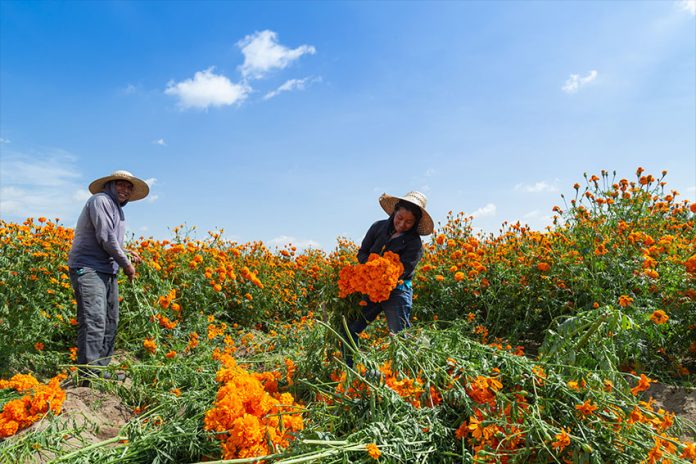Throughout central Mexico, thousands of hectares of cempasúchil (marigold) flowers are blooming, nearly ready for harvest.
The vividly orange blossom is a staple of the upcoming Day of the Dead festivities in November. Their pungent fragrance is said to guide the spirits of the deceased to the altars built by family and friends in their honor. Since pre-Hispanic times, the flowers have been used in food, as a source of dye and for their medicinal properties.
The name comes from the náhuatl word cempōhualxōchitl, meaning “20 flowers.” It’s an appropriate name; though a single marigold looks like one large flower, it is actually many small flowers on a single base. Thirty of the 55 known species of cempasúchil are native to Mexico. The rest are from other areas of the Americas.
Thousands of farmers count cempasúchil among the crops that they cultivate. Puebla leads the pack, producing more than 3/4 of the national harvest by weight in 2021 according to the Ministry of Agriculture. Together, Mexican farmers produced nearly half a million flower bunches in 2021, worth 93.5 million pesos (US $4.7 million).
According to Agriculture Minister Víctor Villalobos Arámbula, the flower has made an impression far beyond Mexico.
“Our cempasúchil has become the protagonist of various festivities in India, North Korea, Japan and other countries,” he said. “In the Hindu lights festival, the floral adornments are mainly composed of cempasúchil; in Bali, Indonesia, the religious adornments made of cempasúchil are so important that the flower has become a true icon of the region.”
Within Mexico, the cempasúchil harvest has generally declined over the years since the government began keeping records in 1980 (though the reported harvest has varied wildly over the years). This could be related to many factors: the small farmers who grew cempasúchil in that decade may have been highly vulnerable to climate variations, causing the harvest to drop in drier years, for example. It is also possible that variation had to do with the challenges the government faced in quantifying a small-scale, artisanal crop that was often grown in remote rural areas.
The biggest spike in production came the same year as Mexico's most deadly earthquake, which occurred on Sept. 19, 1985 and killed thousands. The following year, as the country faced political instability and recovered from the devastating quake, the cempasúchil harvest fell by more than 80%.
But since hitting a low point in 2010 (just over 5800 tonnes were produced that year), the harvest has been trending larger, with a projected haul of 20,245 tonnes for 2022.
Another factor affecting Mexico's cempasúchil harvest is the use of Marvel African Marigold seeds, National Geographic en Español has reported. Despite their name, the seeds are not African but a genetically modified version of a species native to Mexico.
The Marvel African Marigold's small, uniform plant size and the large number of flowers they produce make them convenient for farmers, but they variety is also modified so that its seeds are not fertile. As a result, farmers have to buy relatively expensive imported seeds every year rather than collecting or breeding their own varieties, according Dr. Miguel Ángel Serrato Cruz, a horticultural specialist at the Autonomous University of Chapingo who researches cempasúchil.
The increasing popularity of Marvel African Marigold seeds among Mexican farmers threatens the preservation of the dozens of cempasúchil species native to Mexico, as well as deeply-rooted cultural tradtions, Serrato Cruz said.

He and other Mexican scientists hope to engineer fertile, home-grown alternatives to the imported seeds to preserve the diversity of Mexico's many cempasúchil species while also staying competitive with imported ornamental varieties.
Rose Egelhoff is an associate editor at Mexico News Daily and a freelance writer. You can follow her work on Twitter and the internet.
